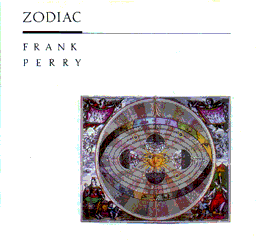
By Richard Elen
Originally published in Sound
Engineer/Producer, April 1986.
HTML edition created March 1997.
This article was made possible
thanks to the kind provision of copies by Jeffrey Silberman...
and by viewers like you.
A brief discussion of Ambisonic recording and mixing equipment was included in this article as a sidebar. It is available here.
During 1985, I was approached by New Age percussionist Frank Perry with a view to recording some material in a rather unusual environment-the White Temple, near Liss in Hampshire.
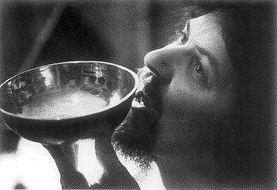
Frank Perry with Tibetan singing bowl
This remarkable building, owned by esoteric organisation White Eagle Lodge, was constructed around 18 years ago, and has a high central dome, with various rooms and facilities arranged in a circle around it. Usually, heavy curtains 'quieten down' the acoustic in the dome, but in early January this year these had been removed for cleaning, leaving an unobstructed recording area which was a good deal 'liver' than I had expected and with a reverberation time of several seconds.
Frank Perry had arrived two days previously and spent most of a day setting up. He is widely recognised as the leading exponent of traditional and modern New Age percussion music, especially the subtle and delicare playing techniques required by some of the most ancient musical instruments in the world.
His range of equipment is prodigious, consisting of modern Western percussion instruments, instruments designed by him and a wide selection of traditional Oriental instruments dating back hundreds of years.
Frank's collection includes a variety of Tibetan 'singing bowls', which haven't been made for over 200 years . These vary in size and can either be struck - in which case their rich harmonics ring on for over 20 seconds - or 'rubbed' with a special birchwood rod.
To rub a bowl, you balance it on yourclosed hand - to damp the sound as little as possible - and, holding the rod vertically, rub it gently round the outside of the bowl.
As rubbing takes place, the sound changes, filling the environment with a gently modulating series of harmonics. These tones also radiate out in different directions and planes. It was my hope that the gear would capture these spatial effects, enhanced by the temple acoustic and that ambisonics would enable it to be re-created for the listener. Previously, the few times they have been recorded, these instruments have tended to be close miked, to get enough level, with a single microphone, so the spatial effects have been lost.
As far as Western instruments are concerned, Frank Perry has a series of symphonic tuned gongs. Some of these have a boss at the centre while others are flat, thus changing the harmonic structure dramatically. But it is his own instruments that are the most interesting.
Frank is an endorsee for Paiste, and has been for some years. As a result he has access to some of the specialised materials produced by the Swiss company. From these he has made sound-plates of varying shapes and sizes- from small triangles to large oblong panels- which produce notes rich in harmonics. Then there are the Petalumins or petal discs, which range in size up to about two feet across They are discs, mounted horizontally with tuned resonators above or below them. Each disc has its edge cut in a multi-petalled shape, the number of petals and their size being related carefully to the size of the disc. The petals enhance the harmonics of the discs, which are amplifed by the resonators. They can ring on for several minutes and are often used by Frank to create complex chords, several being struck in sequence.
Finally, there are several sets of Planicervs -small vertically-mounted discs which are bowed so that only the high harmonics are produced.
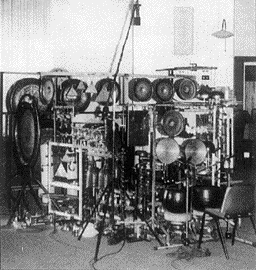
Frank's complete setup, with overhead Soundfield mic
While setting the instruments up took considerable time, in contrast the recording equipment took only the evening to construct. Central to the proceedings was a Calrec Mk IV Soundfield mic, which I placed on a large boom stand about 15 feet above the floor - more or less in the exact centre of the building. The Soundfield has an LED to indicate the nominal front of the mic, and this I faced towards the back of Frank's setup.
Theoretically, the actual front of the mic is irrelevant as it can be rotated electronically- but I didn't want to give myself any undue problems. Frank had set up so that the seated position from which he played the smaller bowls was in the centre of the dome-at the front of his gear. As a result, the louder instruments, like the symphonic gongs, round the back were somewhat further away from the mic, while the quiet instruments were closer. As one of the main problems I was expecting was an excess of level on transients from the gongs, this seemed like a good idea. It also maintained the central position of the mic relative to the dome.
I had already listened carefully to the smaller instruments on an earlier occasion and decided that there was a good chance that some of them-particularly the quieter singing bowls-would be down in the background noise if I relied entirely on the Soundfield. With this in mind, I installed a coincident pair of standard Calrec cardioid condenser mics pointing through the front of Frank's setup and angled slightly downwards towards the small bowls on the floor. These would additionally pick up a held, rubbed bowl effectively. The installation of a headphone box, a pair of headphones and the required mic and foldback cables completed the set-up in the 'studio' dome.
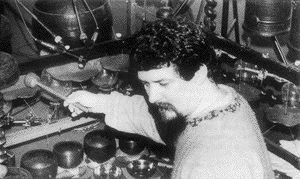
Frank Perry playing a Petalumin. Note the Calrec coincident pair to the upper left of the picture
In the 'control room' I assembled the rest of the gear. In front of me, facing the door to the dome, went the console - a Soundcraft 200B 24/4/2 unit lifted from our music programming suite back at the studio. In fact, very few of the facilities of this excellent console were required: I was usually using no more than two channels (bring the Calrec cardioids up to line level) and generally no EQ, plus the stereo tape return for monitoring.
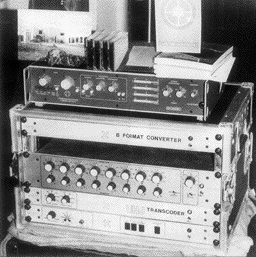
A view of the recording equipment.
The Calrec control unit is on top; the unit with all the knobs is the pan-rotate,
while the unit beneath it is the Transcoder. At the bottom is the UHJ/B-Format
decoder.
On the right of the console I assembled the digital gear. I knew that while many of the pieces would be done in one take, complete, some of them would require overdubs. So most of the time, the ambisonic gear would be fed straight into the digital processor, its output taken to the console tape return for monitoring. But occasionally, I would have to take the basic track from the output into the console, add the mic signals for the overdub - in the analog domain, unfortunately - and record the result.
This is possible with a single digital processor and two video recorders, as the Sony processor's encode and decode circuitry can be used independently. The technique I used was to place the basic track tape on one video machine, running its video into the 'video in' on the processor; take the analog output back to two console channels' line in, routed to groups one and two; bring the ambisonic mic balance up two other line inputs, routed to the same groups; feed these groups into the analog mput of the processor; and take the 'video out' line from the processor into the second video machine.
In this configuration, the simplest way of monitoring is to listen on headphones to the processor output, or monitor the groups. Foldback can be derived from the Soundcraft monitor panel or from the channels.
There is one disadvantage to this way of working: the Sony processor, when it is receiving a video input, monitors the replay signal and not the record side. Only the overload indicators tell you if the input signal is too high! There was, therefore, a certain amount of guesswork involved, as although the console meters would tell you what was going on tape, they are VUs, and peak reading meters are essential for material with these kinds of hefty transients.
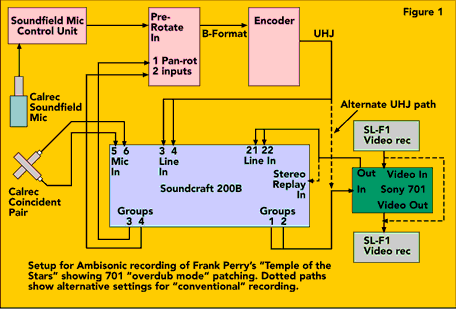
Figure 1 details the set-up for this 'overdub' mode. The dotted paths are those used for 'normal' recording - with one video recorder and the mic signals sent straight to the processor, using the console only for monitoring.
When recording with Sony F1 or 701-type digital processors, I always like to leave open the possibility of lifting the bitstream in the digital domain into a 1610 system, either for editing or for compact disc release. As a result, one fact of these processors must be borne in mind - that of time-correction.
It is well known that the F1 and 701 use a single converter, which carries out switching between channels during sampling. As a result, the actual bitstream on tape has a small delay between channels. Although the delay is corrected naturally on analog replay through the unit, this is little good to you if you have lifted the bitstream between times on to a 1610 or 1630, which does not have such a delay.
Audio Design Calrec, with their professional 701 ES - or with their add-on Propak unit - get around this problem by adding a delay on one channel on the way into the unit, and putting the same length of delay on the output of the other channel to compensate. The result is a Coincident Time Corrected (CTC) tape, with no delay in the digital domain. If you are expecting to transfer recordings digitally to 1610 and don't want the (uncorrectable) digital equivalent of an azimuth error, make sure you use an Audio + Design 701 or a Propak.
The installation of the two SL-F1 Betamax machines and the 701 ES completed the digital set-up. On the left of the console I set up the monitoring amp - an HH V200 driving a pair of KEF Concords on chairs in front of me - and the ambisonic equipment, consisting of the Calrec Soundfield mic control unit and the Audio + Design Ambisonic Mastering Package.
The idea with the Frank Perry recordings was to capture the sound of his instruments and the excellent temple acoustic in Ambisonic surround-sound. For this, I took the B-Format feed (a standard five-pin XLR) from the Soundfield mic into the Pan-Rotate unit's 'pre-rotate' input. This enabled me to use the main rotate control to turn the mic through 180 degrees. Meanwhile, the crossed pair was fed into two of the 360 degree panpots, which were switched to be summed with the Soundfield signal after the main rotate control.
I positioned the two mic feeds in the surround just in front of East and West - these positions gave the best stereo effect on headphones and experience has shown me that coincident pairs can be potted into ambisonics most effectively in this way. The combined signal then went to the B-Format input of the transcoder for encoding into UHJ, and the two-channel output was fed to the digital system (or the console in the case of overdubs).
Monitoring was undecoded UHJ only - on headphones or the KEFs, as I trust the equipment a great deal and have enough experience of listening to undecoded UHJ to know what's going on. In addition, many listeners will hear the pieces in stereo only, so I wanted to be sure they would get the best results. A useful rule of thumb with ambisonics is to perform final monitoring in the simplest likely listening configuration. For example, when mixing library music, where much of the usage is in mono, I will monitor the final mix in mono as I put it down. I've tended to find that if you look after the simplest levels, the more sophisticated configurations look after themselves. I've yet to be disappointed in this respect, and, though monitoring in stereo on these sessions, I found the surround to be entirely satisfactory when listening back at the studio.
Interestingly, while I've used the mixing system since it was introduced, I'd had little experience with the Soundfield mic before these sessions. It turned out to be a joy to use.
In ambisonic configuration, the B-Format can be looped out to the tape machine and back, and you can switch the comprehensive rotate and dominance controls into either the record or the replay side of the chain. You can derive a stereo signal from either path through the unit as well.
I was only interested in using the B-Format signal, so I derived the feed from the 'record' socket on the control unit. I also switched the rotation and dominance controls out of circuit, preferring simply to rotate the mic at the pan-rotate unit. The only control I used on the Soundfield control unit was the 'invert' button - as the mic was hanging from the boom rather than being upright.
Owing to the problems caused by outside traffic noise etc the ambient noise level on tape is not as low as it would have been in a conventional studio - but then, we were there to take advantage of the acoustics.
Calrec has made a very high quality microphone in the Soundfield - and the Mark IV is an improvement on previous models as far as noise is concerned. Overall system noise was well down, with little contribution from any of the mics, the Mastering Package or the digital system. Most electronic noise came from the monitoring side. This was just as well, as dynamic range was a fundamental problem.
I was particularly concerned to try and maintain the natural dynamics of Frank's instruments and his playing, but I had to ensure that on the one hand the louder gongs and petal discs didn't hit the overload lights, while on the other the quieter bowls didn't disappear under the noise. A mild compromise was in fact necessary, dropping the level of the Soundfield gently during loud gong passages; fading up the coincident pair on the singing bowls and keeping it out or in the background at other times.
Listening back to the tapes, the slight 'manual compression' is unnoticeable, and maintaining the level of the Soundfield while the coincident pair was faded up ensured that the acoustic of the temple - and the vital interaction of the instruments with it - is not disturbed, even during surround replay. The effect is of 'focusing in' gently on the quieter instruments as they appear. All the sounds are remarkable - some of them especially so, enhanced by that excellent acoustic. Like the slow, deep playing of a harmonic series from a four-foot home-made bamboo flute. To hear the results and judge for yourselves, you'll just have to keep your eyes open for albums*.
